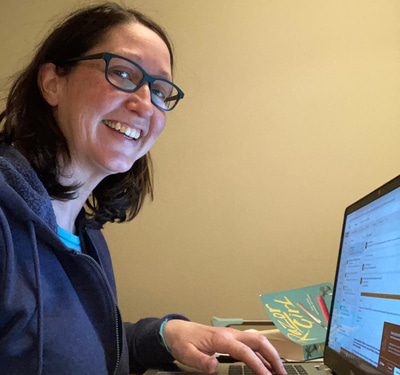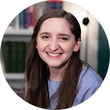- OT
- Life in practice
- Practitioner stories
- “Being able to get ideas from other contact lens educators is invaluable”
What I have learned
“Being able to get ideas from other contact lens educators is invaluable”
Founding member of the British and Irish Universities and Colleges Contact Lens Educators, Richard Pearson, and Claire McDonnell, communications officer for BUCCLE and lecturer at TU Dublin, discuss idea-sharing, changes in contact lens education and adjusting to COVID-19

24 January 2021
What are some of the changes you have seen in contact lens education while a member of the British and Irish Universities and Colleges Contact Lens Educators (BUCCLE)?
Claire McDonnell (CM), lecturer in optometry and ophthalmic dispensing at TU Dublin and communication officer for BUCCLE: I joined BUCCLE in June 2016. One of the key changes for us in TU Dublin was an increased emphasis on scleral lens fitting, which we had previously only taught theoretically. Through BUCCLE we were able to get Andrew Elder-Smith, who was a consultant with Bausch & Lomb at the time, to come to Dublin to give two scleral lens workshops. These workshops gave staff and students hands-on experience and as a result of the workshops, we now have a thriving scleral lens fitting service in TU Dublin.
My colleague and I also learned about BUCCLE member institutions dry eye clinics, and how other universities were developing myopia control clinics. As a member of BUCCLE, TU Dublin’s on-campus clinic was one of the first sites in Ireland to be given a trial bank of CooperVision’s MiSight. While we do not have a dedicated myopia control clinic, both staff and students now fit many patients with myopia control lenses and we receive referrals in from other practitioners.
I think that we have really started to appreciate the fact that, collectively, we have a lot of resources that we can share with each other
What are the key areas that BUCCLE focuses on for research? How does this influence methods or content of teaching?
CM: Normally, the group identifies an area of teaching for which there is very little evidence base and, if practical, we then carry out research to address this deficit. We then use the results of the research in order to inform our teaching. For example: we were all teaching that new soft lens wearers had to build up their wearing time slowly. We suspected that this was probably unnecessary with modern silicone hydrogel lenses (SiHy) but there was no published evidence on this topic.The research subcommittee therefore designed a study to answer this question. By letting undergraduates carry out the research in four different institutions, we were able to get enough patients enrolled to confirm our hypothesis. We now teach that it is not necessary for new daily disposable SiHy wearers to build up their wearing time slowly.
One of the key successes here is involving undergraduates. They can see that their research has meaning and is eventually published, and they feel part of a wider network.
Can you tell us how COVID-19 impacted the group and how the group adapted to those challenges?
CM: The initial impact of COVID-19 was the need to suddenly assess students in online open book exams and the fact that we could not meet in person. We did not meet virtually until the summer but, in the meantime, we had numerous email discussions about how we would assess our students. At a meeting in September, we discussed how the results of this year’s students compared to previous years. Latterly, questions have been asked around the assessment of practical skills virtually and how practical sessions are being run.All of these discussions give members ideas about how they might adapt their teaching and assessment, but they also arm us with information on what other institutions are doing. For example, one member asked if anyone was assessing anterior eye assessment via slit lamp online and if so, how were they doing it. All other members responded that they were continuing to do this assessment in person. This allowed the member who posed the question to go back to their own institution and say that no other optometry or contact lens optician programme was attempting to assess students in this area online.
What are the main focuses for the group in the year ahead?
CM: There is some ongoing undergraduate research that has been delayed by COVID-19 that has to be finished and will hopefully then be published.We have a shared folder on the cloud and at the moment we are building up a repository of online resources, such as case discussions and images for use by members in teaching and assessment.
One of the key successes here is involving undergraduates. They can see that their research has meaning and is eventually published, and they feel part of a wider network
What have been some of the learnings that BUCCLE has taken from the challenges of this year and adaptations required in contact lens fitting and education?
CM: One key learning has been the importance of collaboration. I think that we have really started to appreciate the fact that, collectively, we have a lot of resources that we can share with each other and that there is often no need for us to create new resources from scratch when we can just reach out to other BUCCLE members.Contact lens fitting in practice probably changed less than we initially anticipated. Face masks and slit lamp breath shields are obviously new editions to the fitting and aftercare of patients. Some practitioners are choosing to also wear gloves (both in practice and in an education setting) but many are happy (and equally correct) in simply practising strict hand hygiene. The move to online lecturing was not exactly simple but perhaps less problematic than we thought it would be. This is probably because all third level lecturing moved online, while it hasn’t always been plain sailing, both students and staff accept that this is a temporary pivot and things are not always going to be perfect.
What have you learned from celebrating the 40th anniversary of BUCCLE?
CM: Previous members have reflected on how important BUCCLE was for them. The information that they could share at meetings and the support for each other was invaluable in an age before online communication and information. Now, as more optometry programmes open in the UK, new members from these programmes echo that sentiment in feeling supported and part of a network. Often in a new programme, the BUCCLE member may be the only staff member teaching contact lenses and so being able to get ideas from other contact lens educators is invaluable.BUCCLE provided a degree of harmonisation between the universities
The formation of BUCCLE
For many years, contact lens teachers from the departments of optometry in the UK had joined each other for lunch when participating in oral and practical contact lens examinations for bodies such as the British Optical Association. Principally, we were keen to share information about the management of our contact lens clinics, such as charges made for contact lens, or arrangements for the care of patients who encountered an 'emergency' out of hours. Don and I immediately saw the benefit of forming an association in the UK, similar to AOCLE, to replace and expand those hurried lunchtime conversations. Following a positive response to an exploratory meeting held at City University in October 1980 to consider the formation of such a group, the first formal meeting of BUCCLE was held at Aston that December. We all anticipated eagerly the benefits of sharing ideas and resources.
How did being a chair and member of the group influence or support your work in education?
RP: A most useful outcome of BUCCLE meetings was the comparison of information on syllabus, the format of examinations, and the content of coursework, together with methods of assessing student’s performance. It was also very helpful to have discussions and to share experiences relating to a wide range of issues associated with the fitting of contact lens patients in teaching clinics.
Additionally, these gatherings made it possible to see first-hand contact lens related research projects being conducted within the university hosting the meeting. BUCCLE also provided a degree of harmonisation between the universities. When the original British standard on contact lens terminology was replaced with an international one, terms such as ‘back central optic radius’ became ‘back optic zone radius’ and ‘overall size’ became ‘total diameter.’ BUCCLE agreed that every optometry department should adopt the new terminology at the same time.
What are some of the ways you feel contact lens education has changed in the time that BUCCLE has been operating?
RP: The fundamental aim of contact lens education is to provide an understanding of the physiological implications of contact lens wear, indications and contra-indications for contact lens fitting, the selection of an appropriate type of lens in each case, assessment of the fit of the lens, aftercare of the patient and the management of complications.
Although this objective remains unaltered, the means of achieving it has changed due to technological advances. One example is the advent of video slit-lamp microscopes in teaching clinics, which has made it possible to provide a demonstration to a group of students, whereas the optical teaching eyepiece could only be used by one student at a time.
A second example relates to the need to keep abreast with current research. It was necessary to visit the university library frequently to search through hard copies of a range of journals. Today, such searches can be achieved online in the educator’s office, in the home or even while travelling.
Although this objective remains unaltered, the means of achieving it has changed due to technological advances
What were some of the challenges or opportunities in contact lens education when you established BUCCLE?
RP: The scope of BUCCLE’s activities was initially limited by a lack of funds. Various companies, especially those with knowledge of AOCLE and IACLE, soon understood the mutual benefit of providing sponsorship and having direct and simultaneous contact with a group of key educators in the UK.
The opportunity presented by BUCCLE was the benefit from collaboration with others in order to achieve the highest possible standard of teaching and to identify research areas of mutual interest.
In light of the changes that COVID-19 has brought, what do you feel are the challenges for contact lens educators currently, and are there any opportunities?
RP: COVID-19 imposed a sudden need to deliver all lectures online. Just as any recording provides a limited substitute for a live musical performance, educational sessions that I have watched via Zoom have lacked something in comparison with the ‘in person’ presentations. In particular, I have sometimes struggled with graphs and tables on a small screen. It would be interesting to know how students have found online lectures compared with ‘live’ ones. If recorded lectures were available, did these encourage repeat viewing as an aid to revision?
The need to provide hands-on introductory training in contact lens fitting and the need to assess students’ competence must have presented an almost impossible challenge for educators and an even greater problem arises in final year clinics, which normally necessitate the close proximity of patients, students and their supervisors.
The internet has long made it possible to invite an expert, possibly one based overseas, to give a virtual lecture on a topic in which they have special expertise. It may be that the current need for online teaching might encourage the exchange of lectures between universities.


Comments (0)
You must be logged in to join the discussion. Log in